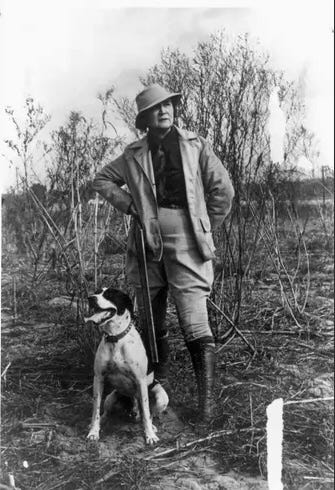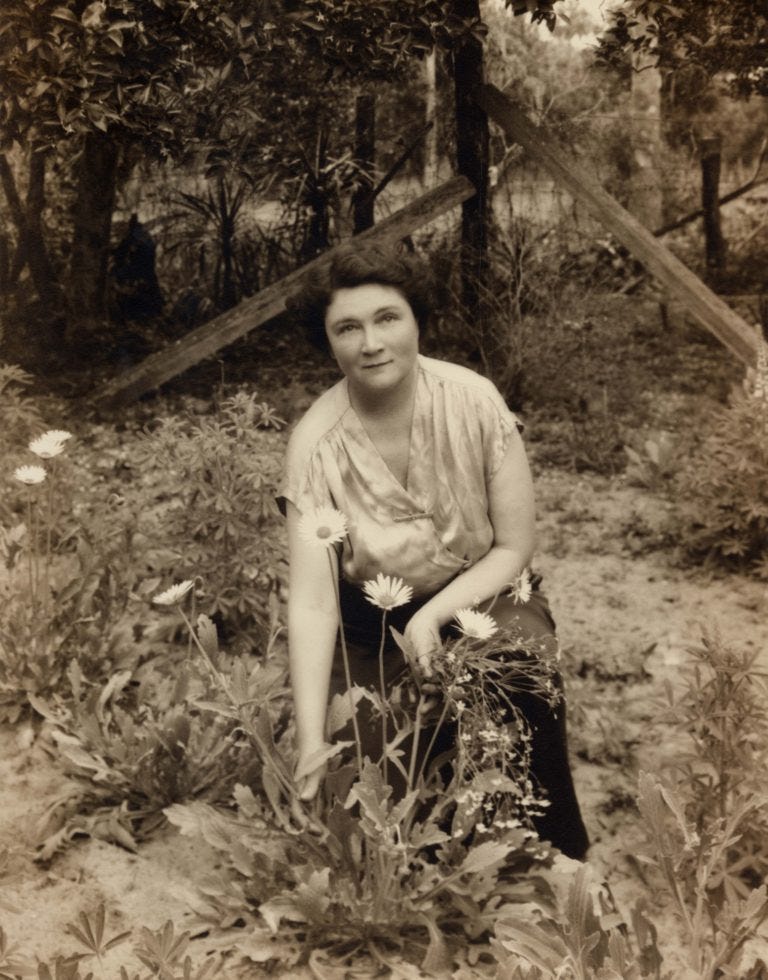Memoirist Kim Barnes suggests that, “For a life to be dramatically whole, it must contain an experience one can look back on and say, that is where my life changed. There was before. There is after. And always there is that.” Most who are familiar with Pulitzer-prize winning author Marjorie Kinnan Rawlings would point to her purchase of the 74-acre Cross Creek farm in Central Florida as her “that.” For it was there that she evolved from a struggling journalist to a nationally renowned author and, in the process, became one of Florida’s first conservationists.

Cracker Culture As Muse
Before moving to Cross Creek, Marjorie’s writing consisted primarily of opinion pieces, social columns, and poetry for newspapers in Rochester and Louisville. However, that all changed after she encountered her Cracker neighbors in central Florida. Their unique language and culture so intrigued Marjorie that she worked feverishly to capture both in a series of Cracker essays that were published by Scribner’s magazine in 1931. Encouraged by this success, Marjorie embarked on writing a full-length Cracker novel titled "South Moon Under." To prepare, she spent 10 months living with a Cracker family in the “Big Scrub,” an area located deep within the Ocala National Forest. The experience changed Marjorie. She began to understand how the Crackers depended on the region’s natural resources and how those resources had been devastated by decades of unrestricted timber harvesting. The devastation could be observed and counted as Florida’s collective cypress and pine stands dwindled from a combined 27 million acres to 6 million acres between 1880 and 1930.
A Turn Towards Conservation
Marjorie integrated the environmental devastation of the timber forests into “South Moon Under” and her narrative reflected the beginnings of a personal transformation. She had arrived at Cross Creek in 1928 as a woman who appreciated the beauty of nature and yet still adhered to the Judeo-Christian belief that humans possessed dominion over the natural world. In “South Moon Under,” she used her primary characters to express dismay at the environmental devastation and to place the blame squarely on the timber companies. Fifteen years later, Marjorie would directly express her evolved perspective regarding the human/nature relationship in her memoir, “Cross Creek:”
“It seems to me that the earth may be borrowed but not bought. It may be used, but not owned. It gives itself in response to love and tending, offers its seasonal flowering and fruiting. But we are tenants and not possessors, lovers and not master. Cross Creek belongs to the wind and the rain, to the sun and the seasons, to the cosmic secrecy of seed, and beyond all, to time.”

After publishing “Cross Creek”, Marjorie went on to produce a series of conservation related articles. In 1943, at the request of the US Forest Service, she prepared an essay for Collier’s magazine, which involved a 5,000 mile tour of timber forests across the Southeast. Marjorie was deeply disturbed by what she saw. The rate of timber harvesting was vastly exceeding any new plantings by 3 billion board feet with the demands of war only exacerbating the disparity. In response, Marjorie proposed a two-fold solution. First, she advocated for a shift in philosophy whereby timber forests would be treated as crops with only large, mature, trees being cut and the others left to grow for future harvests. Second, she proposed federal legislation that would establish a comprehensive system of controlled cutting that would provide “for the greatest good to the greatest number.” This part of her proposal reflected the work of Gifford Pinchot who had been the nation’s first chief of forestry and the founder of the national conservation movement.
In 1944, Marjorie directed her conservationist eye towards the broader topic of Florida’s future as she authored “Florida: A Land of Contrasts” for Transatlantic magazine. In the article, Marjorie maps a brief history of Florida and the historical conflict between pro-conservation and pro-development advocates, which she characterized as a battle for the Florida of William Bartram, a British botanist who explored Florida in 1765, or the Florida of the Chambers of Commerce.
One of Marjorie’s last conservationist writings appeared during centennial celebrations marking Florida’s admission into the Union in 1845. To mark the occasion, Representative Joseph Hendricks invited Marjorie to prepare written comments that he incorporated into his speech on the House floor. After a moving narrative describing the state’s natural beauty, she used her closing paragraph to make a sweeping attack on the timber industry, real estate developers, and tourism promoters.
Shortly after the centennial celebrations, Marjorie Kinnan Rawlings left Cross Creek. Exhausted from a protracted court battle with a local resident and recently married to hotelier Norton Baskin of St. Augustine, she chose to spend more time at her home in Crescent Beach near Norton’s hotel. However, her work as an early conservationist became a central thread in the story of efforts to restore Central Florida’s pine forests. Today, her home region includes several conservation areas focused on the management of water resources, wildlife, and forests.
Marjorie’s Wild Spaces
Marjorie Kinnan Rawlings Historic State Park (The homestead of Marjorie Kinnan Rawlings, which is open for public tours.)
Ocala National Forest (The forest was established by President Teddy Roosevelt in 1908 and it is where the National Forest Foundation is currently working to restore the longleaf pine ecosystem.)
Grove Park Wildlife Management Area (The WMA consists of 16,437 acres with large stands of pine, live oak, and hardwood swamps.)
Lochloosa Wildlife Management Area (The Lochloosa area encompasses 11,000 acres of pine plantations and oak ridges, which provide habitats for eagles, osprey and wading birds).
Notes
Wilkins, Joe. “A Review of When Things Get Dark, A Mongolian Winter’s Tale.” Orion Magazine, https://orionmagazine.org/review/when-things-get-dark/. Accessed 25 Feb. 2021.
Drobney, Jeffrey A. “Company Towns” Florida Historical Quarterly.
Rawlings, Marjorie Kinnan. "Trees for Tomorrow." Collier’s Magazine, May 8 1943, pp. 14-15, 24-25.
Rawlings, Marjorie Kinnan. “Florida: A Land of Contrasts.” Transatlantic, no.14, Oct. 1944, pp.12-17.
Rawlings, Marjorie Kinnan. “Florida: A Land of Contrasts.”




Marjorie Kinnan Rawlings has only recently been recognized as an early conservationist. Do you know of other women who used their talents to advocate for a wild southern space. Please share!
Ginger, hello. I had not seen that photo of Marjorie in her garden, and I'm very glad that you dug it out. And I see that we share many common interests. Many thanks for this.